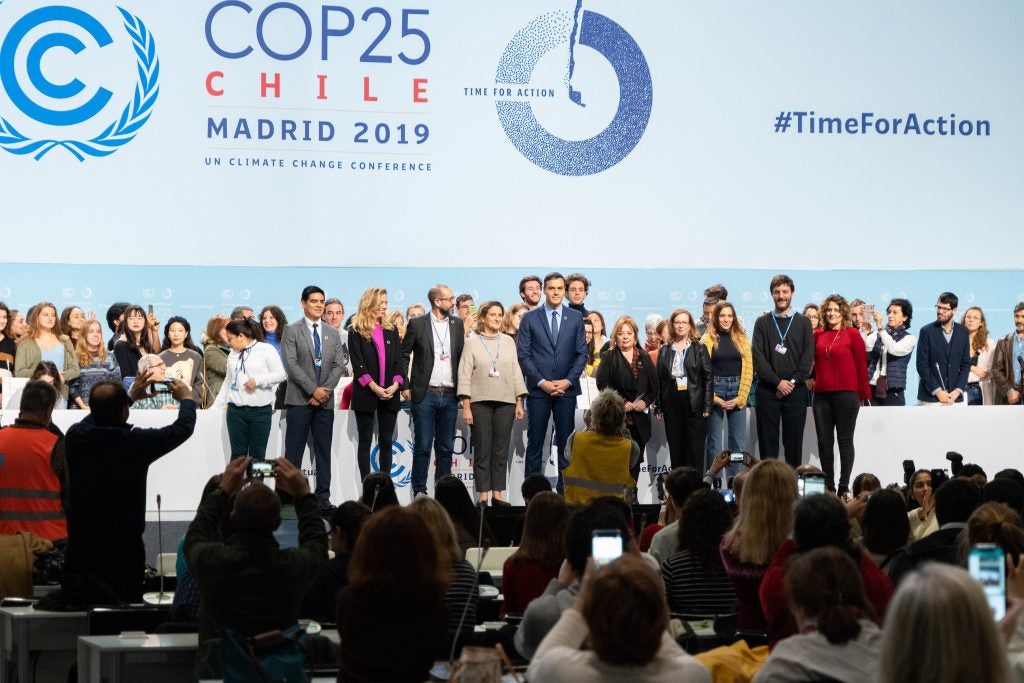International cooperation on carbon markets, covered in Article 6 of the Paris Agreement, is at the top of the agenda for the COP 25 climate talks in Madrid this week. Since leaving the Article 6 section of the Paris Agreement without agreement at COP 24, negotiators have continued to work over the past year to garner support for a deal, before countries shift focus to preparing their critical next round of NDC pledges, due next year.
They will do this against a backdrop of political disruption, but continued determination to finalize the Paris Agreement’s operating instructions, known in the UN as the “rulebook”.
Civil unrest in Chile led that country’s president to take the unprecedented step of canceling the climate conference only five weeks before its scheduled start. Spain quickly stepped in the next day to offer to organize the negotiations, known as COP 25, in Madrid. The United States earlier this month officially began the process to withdraw from the Paris Agreement. All this is happening while the increasing impacts of climate change are being felt around the world; fires have ravaged Australia and California, while historic flooding is drowning Venice and dangerous pollution is choking Indian cities. And a new World Meteorological Organization report confirms that the atmospheric concentration of three key greenhouse gases – methane, CO2, and nitrous oxide – continues to rise.
Although the ultimate success of the Paris Agreement will be judged many years from now, how the rules on international carbon markets are decided in Madrid could make or break the ambition of the Paris Agreement.
That’s because international carbon market cooperation underpinned by strong accounting and transparency rules can help drive emissions down significantly: research shows that well-designed carbon markets could nearly double the ambition of current national climate pledges, at no extra cost.
However, weak rules for carbon trading between countries could fundamentally undermine the Paris Agreement. By allowing countries and the private sector to “count” carbon credits that don’t represent real emissions reductions, a bad set of rules on Article 6 could negate the climate ambition of current climate pledges.
What is a good Article 6 agreement?
Here’s what to look out for in the Article 6 negotiations – the issues that can determine whether the rules governing carbon markets will be strong or weak.
- Robust accounting to prevent double counting across all of the elements of Article 6. The Paris Agreement is clear that avoiding double counting of emissions reductions through the application of corresponding adjustments is a “must” when countries participate in voluntary cooperation under Article 6. However, Parties have differing opinions on the circumstances under which a corresponding adjustment is required. These details matter. Strong Article 6 rules will require equal accounting treatment of all transfers of emissions reductions, including transfers under Article 6.4’s centralized carbon market mechanism, as well as transfers towards other international climate commitments (for example, towards airlines’ emission reduction commitments under the Carbon Offsetting and Reduction Scheme for International Aviation (CORSIA), developed under the International Civil Aviation Organization).
- Sunset of the Clean Development Mechanism (CDM): The CDM was established to meet commitments under Article 3 of the Kyoto Protocol, and those commitments do not extend beyond 2020. Article 6 rules should ensure that Kyoto Protocol units, many of which are of questionable environmental integrity, should not be used in a post-2020 context, since their existing surpluses could water down the ambition of countries’ Paris Agreement targets;
- Supporting more ambitious NDCs over time: Article 6 rules should be designed to incentivize ambition and progression of national climate targets, by supporting all countries moving to economy-wide emission reduction targets over time;
- Regular, public reporting of progress: Transparency is vital to strengthening ambition and is a hallmark of effective existing carbon markets at the national and subnational level. Transparency rules must ensure that countries cooperating under Article 6 publicly and quantitatively track their progress no less than every two years towards implementation and achievement of their climate pledges, measuring their transferred emission reductions in the common, well-established carbon-market metric of tonnes CO2 equivalent.
- Transparent and predictable funding for adaptation, generated through a levy on international units sold under Article 6.4’s centralized, UN-governed carbon market mechanism.
Agreeing strong rules on the items above would set the foundation for high-integrity international carbon market cooperation. The additional nuts and bolts of practical carbon market cooperation would need to be worked out by participating countries themselves, consistent with the “bottom up” approach of the Paris Agreement. Although the Paris Agreement provides a framework for international cooperation on carbon markets, it is ultimately up to countries to work together to agree the detailed rules necessary for international carbon markets to drive emissions down and investment up.
Article 6 agreement or bust? Not so fast.
The good news is that agreeing these three fundamental rules in Madrid could catalyze substantial, early progress in Article 6 cooperation among countries.
But no rules will be better than bad rules. If no agreement on strong standards is possible at COP25, countries can work in small groups, or “clubs,” to set the bar for high-integrity cooperation.
A “minilateral” club of carbon markets could complement efforts under the UNFCCC by fostering agreement on robust standards for the accounting, transparency and environmental integrity of internationally transferred emissions units.
The Paris Agreement began a new, more ambitious chapter in the history of climate action, but much of the chapter related to carbon market cooperation is yet to be written. We’re in the race of our lives to finish the work of protecting future generations and building prosperous, 100% clean economies. Agreement on carbon market standards in Madrid, or among a coalition of carbon markets if necessary, can help deliver on the promise of the Paris Agreement and catalyze the deep global emissions reductions that climate science demands.










